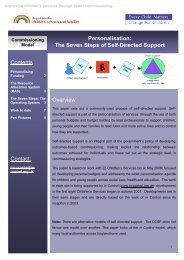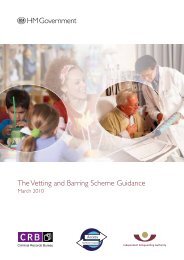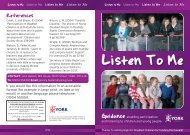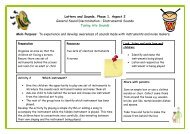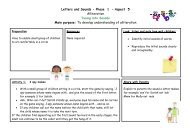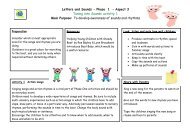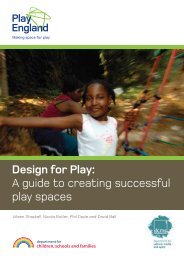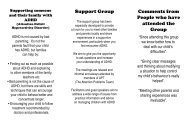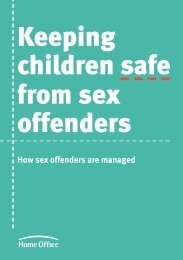The common core of skills and knowledge - Knowledge Hub
The common core of skills and knowledge - Knowledge Hub
The common core of skills and knowledge - Knowledge Hub
Create successful ePaper yourself
Turn your PDF publications into a flip-book with our unique Google optimized e-Paper software.
1<br />
<strong>The</strong> children <strong>and</strong> young<br />
people’s workforce<br />
Rachael Holdgate, Study Support Manager <strong>and</strong> Henna<br />
Area Coordinators Tracey Andrews <strong>and</strong> Helen Clover with Sure<br />
Start Family Support Worker Wenita Luther (centre)<br />
<strong>The</strong> <strong>common</strong> <strong>core</strong> <strong>of</strong><br />
<strong>skills</strong> <strong>and</strong> <strong>knowledge</strong><br />
At the heart <strong>of</strong> what you do
2<br />
“Having the <strong>common</strong><br />
<strong>core</strong> ensures there’s<br />
a consistent quality,<br />
so whoever a young<br />
person chooses to<br />
approach will know how<br />
to talk to them, how<br />
to recognise if things<br />
are wrong <strong>and</strong> how to<br />
bring in other services<br />
if they’re needed.”<br />
Joanna Nichols, Teenage<br />
Pregnancy Strategy<br />
Co-ordinator
Contents<br />
1<br />
02 Introduction<br />
04 <strong>The</strong> children <strong>and</strong> young people’s workforce<br />
06 Effective communication <strong>and</strong> engagement<br />
with children, young people <strong>and</strong> families<br />
10 Child <strong>and</strong> young person development<br />
13 Safeguarding <strong>and</strong> promoting the welfare<br />
<strong>of</strong> the child or young person<br />
16 Supporting transitions<br />
18 Multi-agency <strong>and</strong> integrated working<br />
22 Information sharing<br />
<strong>The</strong> Department for Children, Schools <strong>and</strong> Families <strong>and</strong> the Children’s<br />
Workforce Development Council work together to support integrated working.<br />
Visit www.everychildmatters.gov.uk/integratedworking for more information.
2<br />
Introduction<br />
This is the <strong>common</strong> <strong>core</strong> <strong>of</strong> <strong>skills</strong> <strong>and</strong><br />
<strong>knowledge</strong> for everyone working with<br />
children <strong>and</strong> young people.<br />
<strong>The</strong> <strong>common</strong> <strong>core</strong> describes the <strong>skills</strong><br />
<strong>and</strong> <strong>knowledge</strong> that everyone who<br />
works with children <strong>and</strong> young people<br />
is expected to have. <strong>The</strong> six areas <strong>of</strong><br />
expertise in the <strong>common</strong> <strong>core</strong> <strong>of</strong>fer<br />
a single framework to underpin multiagency<br />
<strong>and</strong> integrated working,<br />
pr<strong>of</strong>essional st<strong>and</strong>ards, training <strong>and</strong><br />
qualifications across the children <strong>and</strong><br />
young people’s workforce. This includes<br />
those who work with children <strong>and</strong><br />
young people all the time as well as<br />
those who work with children <strong>and</strong><br />
young people as only part <strong>of</strong> their job<br />
role. It includes both paid staff <strong>and</strong><br />
volunteers. An overview <strong>of</strong> the children<br />
<strong>and</strong> young people’s workforce is<br />
provided in figure 1 (page 4).<br />
<strong>The</strong> <strong>common</strong> <strong>core</strong> reflects a set <strong>of</strong><br />
<strong>common</strong> values for practitioners that<br />
promote equality, respect diversity<br />
<strong>and</strong> challenge stereotypes. It helps to<br />
improve life chances for all children <strong>and</strong><br />
young people, including those who have<br />
disabilities <strong>and</strong> those who are most<br />
vulnerable. It provides more effective<br />
<strong>and</strong> integrated services.<br />
Gordon Jones (centre), Volunteer Support Worker
3<br />
It is understood that the use <strong>of</strong> the<br />
<strong>common</strong> <strong>core</strong> will vary by sector <strong>and</strong><br />
role, <strong>and</strong> that different organisations<br />
will find the most appropriate ways <strong>of</strong><br />
giving expression to all the six areas <strong>of</strong><br />
expertise. Those who work with children<br />
<strong>and</strong> young people all the time will use<br />
the <strong>common</strong> <strong>core</strong> in different contexts<br />
<strong>and</strong> to different levels <strong>of</strong> depth from<br />
those who come into contact with<br />
children <strong>and</strong> young people as only part<br />
<strong>of</strong> their job. Similarly, some roles will<br />
place greater emphasis on one or more<br />
<strong>of</strong> the <strong>common</strong> <strong>core</strong>’s six headings:<br />
not all practitioners will be regularly<br />
involved in supporting transitions, for<br />
instance; but all will need to underst<strong>and</strong><br />
at least the most important aspects<br />
<strong>of</strong> each <strong>of</strong> the six areas <strong>of</strong> expertise in<br />
a way that is relevant to the context<br />
in which they work. However the six<br />
areas <strong>of</strong> expertise in the <strong>common</strong><br />
<strong>core</strong> work as a whole – many <strong>of</strong> the<br />
<strong>skills</strong> described under one heading are<br />
also relevant to other headings – so it<br />
will be important for individuals <strong>and</strong><br />
organisations to consider the <strong>common</strong><br />
<strong>core</strong> in the round.<br />
<strong>The</strong> <strong>common</strong> <strong>core</strong> ac<strong>knowledge</strong>s the<br />
rights <strong>of</strong> children <strong>and</strong> young people.<br />
It also recognises the role parents,<br />
carers <strong>and</strong> families play.<br />
Families are organised in different<br />
ways, so whenever the <strong>common</strong> <strong>core</strong><br />
refers to parents or carers, it includes<br />
all <strong>of</strong> the following people: biological<br />
mothers <strong>and</strong> fathers, adoptive parents,<br />
step parents, same sex parents, foster<br />
carers, legal guardians, gr<strong>and</strong>parents,<br />
extended family members <strong>and</strong> other<br />
adults who provide care for children.
• Youth<br />
<strong>of</strong>fending teams.<br />
• Staff <strong>and</strong><br />
managers <strong>of</strong>:<br />
youth <strong>of</strong>fending<br />
institutions, secure<br />
training centres,<br />
secure children’s homes,<br />
police in school liaison/<br />
child protection roles.<br />
4<br />
Figure 1: <strong>The</strong> children <strong>and</strong><br />
young people’s workforce<br />
Early years & childcare<br />
Managers & leaders<br />
• Planners, Housing <strong>and</strong> Transport providers/<br />
commissioners.<br />
• HR in organisations that provide services<br />
to children/young people.<br />
• Managers, deputies,<br />
assistants <strong>and</strong> workers in:<br />
• Playgroups.<br />
• Children’s centres.<br />
• Day nurseries.<br />
• Nursery schools.<br />
• Nursery classes in<br />
Primary schools.<br />
• Registered<br />
childminders<br />
<strong>and</strong> nannies.<br />
• Play workers.<br />
• Strategic, senior <strong>and</strong><br />
middle managers in all Children’s<br />
Trust partner organisations.<br />
• All commissioners <strong>of</strong><br />
services for children<br />
<strong>and</strong>/or young people.<br />
• Sports<br />
coaches <strong>and</strong><br />
<strong>of</strong>ficials.<br />
• School <strong>and</strong> FE<br />
sport co-ordinators.<br />
• County Sports<br />
Development <strong>of</strong>ficers.<br />
• Sport competition<br />
managers.<br />
• School library service.<br />
• Health <strong>and</strong> fitness providers.<br />
• Outdoor education/recreation providers.<br />
• Workers in cultural heritage,<br />
museums <strong>and</strong> galleries.<br />
• Performers in visual <strong>and</strong> literary arts.<br />
• Teachers <strong>of</strong> music <strong>and</strong> performing arts.<br />
Sport & culture<br />
• Probation <strong>of</strong>ficers.<br />
• Multi-agency public protection teams.<br />
• Policing <strong>and</strong> law enforcement.<br />
• Prosecution services.<br />
• Custodial care.<br />
Justice & crime prevention
Education<br />
5<br />
• Staff <strong>and</strong> leaders <strong>of</strong> FE Colleges.<br />
• Adult <strong>and</strong> community education providers.<br />
• Primary <strong>and</strong> community health practitioners.<br />
• Clinical practitioners.<br />
• Hospitals.<br />
• Community health services.<br />
• Sexual health services.<br />
• Drugs <strong>and</strong> alcohol services.<br />
• Adult mental health services.<br />
• Head teachers.<br />
• Teachers.<br />
• School support staff.<br />
• Providers <strong>of</strong> extended<br />
schools activities.<br />
• Learning mentors.<br />
• Behaviour & Educational<br />
Support teams.<br />
• 14–19 Providers.<br />
• Educational<br />
psychologists.<br />
• Educational<br />
welfare<br />
• GPs.<br />
• Dentists.<br />
Health<br />
• Health visiting teams.<br />
• School nurses.<br />
• Community Children’s nurses.<br />
• Children’s nurses.<br />
• Child psychologists.<br />
• CAMHS.<br />
• Paediatricians <strong>and</strong><br />
sub-paediatricians<br />
• Community<br />
paediatricians.<br />
• Children’s<br />
allied health<br />
pr<strong>of</strong>essionals.<br />
• Teenage<br />
<strong>of</strong>ficers.<br />
• School<br />
meal<br />
staff.<br />
pregnancy<br />
workers.<br />
•Children<br />
<strong>and</strong> families<br />
social workers.<br />
• Foster carers.<br />
• Play workers.<br />
• CAFCASS advisers.<br />
• Private foster carers.<br />
• Outreach <strong>and</strong> family<br />
support workers.<br />
•Connexions<br />
Personal advisers.<br />
• Youth workers.<br />
• Youth support workers.<br />
• Youth workers in<br />
voluntary, community<br />
or faith sector.<br />
• Young people’s housing <strong>and</strong><br />
accommodation support workers.<br />
• Managers <strong>and</strong> staff in:<br />
family centres,<br />
day centres, residential<br />
children’s homes.<br />
• Portage workers.<br />
• Parenting practitioners.<br />
• Adult social care workers.<br />
• Supporting People teams.<br />
• Drug <strong>and</strong> alcohol workers.<br />
• Housing Officers <strong>and</strong> Accommodation<br />
Support workers.<br />
• Jobcentre Plus advisers.<br />
• Child Support Agency workers.<br />
Social, family & community support<br />
Core Children <strong>and</strong> Young<br />
People’s Workforce:<br />
People who work or volunteer with<br />
children, young people <strong>and</strong> their<br />
families, or are responsible for<br />
their outcomes all the time.<br />
Youth<br />
Wider Children <strong>and</strong> Young<br />
People’s Workforce:<br />
People who work or volunteer with<br />
children, young people <strong>and</strong>/or their<br />
families part <strong>of</strong> the time, or are<br />
responsible for their outcomes<br />
as part <strong>of</strong> their jobs.
6<br />
Effective communication <strong>and</strong><br />
engagement with children,<br />
young people <strong>and</strong> families<br />
1.1 Good communication is central<br />
to working with children, young<br />
people, families <strong>and</strong> carers. It helps<br />
build trust, <strong>and</strong> encourages them<br />
to seek advice <strong>and</strong> use services. It is<br />
key to establishing <strong>and</strong> maintaining<br />
relationships, <strong>and</strong> is an active process<br />
that involves listening, questioning,<br />
underst<strong>and</strong>ing <strong>and</strong> responding. You<br />
should always communicate with<br />
them appropriately to match the<br />
stage <strong>of</strong> development, personal<br />
circumstances, <strong>and</strong> needs <strong>of</strong> the<br />
person you’re talking to.<br />
1.2 It is important to be able to<br />
communicate both on a one-on-one<br />
basis <strong>and</strong> in a group. Communication<br />
is not just about the words you use, but<br />
also about the way you’re speaking<br />
<strong>and</strong> your body language. You need to<br />
feel <strong>and</strong> show empathy <strong>and</strong> sincerity,<br />
<strong>and</strong> above all, listen. You need to take<br />
account <strong>of</strong> culture <strong>and</strong> context. For<br />
example, you need to be aware <strong>and</strong><br />
communicate appropriately if English is<br />
an additional language, or the child is<br />
disabled or at risk <strong>of</strong> under-achievement<br />
or other poor outcomes.<br />
1.3 Effective communication extends<br />
to involving children, young people,<br />
their parents <strong>and</strong> carers in the design<br />
<strong>and</strong> delivery <strong>of</strong> services <strong>and</strong> decisions<br />
that affect them. It is important<br />
to consult the people affected <strong>and</strong><br />
consider opinions <strong>and</strong> perspectives<br />
from the outset. Another crucial<br />
element <strong>of</strong> effective communication is<br />
developing trust between the workforce<br />
<strong>and</strong> children, young people, parents<br />
<strong>and</strong> carers – as well as within different<br />
sectors <strong>of</strong> the workforce itself.<br />
1.4 To build a rapport with children,<br />
young people, their parents <strong>and</strong><br />
carers, it is important to be respectful,<br />
underst<strong>and</strong>ing <strong>and</strong> honest. People<br />
become engaged when relationships<br />
are continuous, <strong>and</strong> their lives improve<br />
as a result.<br />
1.5 <strong>The</strong> <strong>skills</strong> <strong>and</strong> <strong>knowledge</strong><br />
highlighted here <strong>and</strong> throughout<br />
the <strong>common</strong> <strong>core</strong> provide a basic<br />
description <strong>of</strong> areas that may need<br />
development through training,<br />
learning or experience in order<br />
to work effectively.<br />
“<strong>The</strong> team have come down<br />
to Sinead’s level but still<br />
treated her like an adult...<br />
I don’t know what we would<br />
have done without them.”<br />
Mrs Hughes,<br />
mother <strong>and</strong> gr<strong>and</strong>mother
7<br />
Skills<br />
Listening <strong>and</strong> building empathy<br />
1.6 Establish a rapport <strong>and</strong> build<br />
respectful, trusting, honest <strong>and</strong><br />
supportive relationships with children,<br />
young people, their families <strong>and</strong><br />
carers, which make them feel valued<br />
as partners.<br />
1.7 Use clear language to<br />
communicate with all children, young<br />
people, families <strong>and</strong> carers, including<br />
people who find communication<br />
difficult, or are at risk <strong>of</strong> exclusion<br />
or under-achievement.<br />
1.8 Be able to adapt styles <strong>of</strong><br />
communication to the needs <strong>and</strong><br />
abilities <strong>of</strong> children <strong>and</strong> young people<br />
who do not communicate verbally,<br />
or communicate in different ways.<br />
1.9 Build a rapport <strong>and</strong> develop<br />
relationships using the most<br />
appropriate forms <strong>of</strong> communication<br />
(for example, spoken language,<br />
visual communication, play, body<br />
<strong>and</strong> sign language, information <strong>and</strong><br />
communication technologies) to meet<br />
the needs <strong>of</strong> the individual child or<br />
young person <strong>and</strong> their families<br />
<strong>and</strong> carers.<br />
1.10 Hold conversations at the<br />
appropriate time <strong>and</strong> place,<br />
underst<strong>and</strong>ing the value <strong>of</strong> regular,<br />
reliable contact <strong>and</strong> recognising that<br />
it takes time to build a relationship.<br />
1.11 Actively listen in a calm, open,<br />
non-judgemental, non-threatening way<br />
<strong>and</strong> use open questions. Ac<strong>knowledge</strong><br />
what has been said, <strong>and</strong> check you have<br />
heard correctly.<br />
1.12 Make sure that children, young<br />
people, parents <strong>and</strong> carers know they<br />
can communicate their needs <strong>and</strong> ask<br />
for help.<br />
Summarising <strong>and</strong> explaining<br />
1.13 Summarise situations in the<br />
appropriate way for the individual<br />
(taking into account factors such as<br />
background, age <strong>and</strong> personality).<br />
1.14 Present genuine choices to children<br />
<strong>and</strong> young people, explaining what has<br />
happened or will happen next <strong>and</strong> what<br />
they are consenting to.<br />
1.15 Decide together how to involve<br />
parents or carers in the choices<br />
to be made.
8<br />
Effective communication <strong>and</strong><br />
engagement with children,<br />
young people <strong>and</strong> families<br />
Consultation <strong>and</strong> negotiation<br />
1.16 Consult the child or young person,<br />
<strong>and</strong> their parents or carers from the<br />
beginning <strong>of</strong> the process.<br />
1.17 Make informed judgements about<br />
how to involve children, young people,<br />
parents <strong>and</strong> carers in decisions as far<br />
as is possible <strong>and</strong> appropriate. Take<br />
account <strong>of</strong> their views <strong>and</strong> what they<br />
want to see happen. Be honest about<br />
the weight <strong>of</strong> their opinions <strong>and</strong> wishes.<br />
1.18 Inform, involve <strong>and</strong> help the child<br />
or young person to express what they<br />
are feeling. Help them to describe what<br />
they are experiencing <strong>and</strong> to assess<br />
different courses <strong>of</strong> action. Help them<br />
underst<strong>and</strong> the consequences <strong>of</strong><br />
each <strong>and</strong>, where appropriate, agree<br />
next steps.<br />
1.19 Recognise that different people<br />
have different interests in a situation<br />
<strong>and</strong> be able to work with them to reach<br />
the best <strong>and</strong> most fair conclusion for<br />
the child or young person.<br />
1.20 Share reasons for action with<br />
the child or young person <strong>and</strong> their<br />
parent or carer, unless to do so would<br />
increase the risk <strong>of</strong> harm to them or<br />
another person.<br />
1.21 Judge when, <strong>and</strong> how to h<strong>and</strong><br />
over control <strong>of</strong> a situation to others.<br />
<strong>Knowledge</strong><br />
How communication works<br />
1.22 Underst<strong>and</strong> the value <strong>of</strong> the role<br />
<strong>of</strong> parents <strong>and</strong> carers, <strong>and</strong> know how<br />
<strong>and</strong> when to refer them to further<br />
sources <strong>of</strong> information, advice<br />
or support.<br />
1.23 Know that communication<br />
is a two-way process.<br />
1.24 Know how to listen to people,<br />
make them feel valued <strong>and</strong> involved.<br />
1.25 Underst<strong>and</strong> the importance<br />
<strong>of</strong> building good relationships with<br />
children, young people, their parents<br />
<strong>and</strong> carers.<br />
1.26 Know when it is important to focus<br />
on individuals <strong>and</strong> when it is important<br />
to focus on groups.<br />
1.27 Know how your attitude <strong>and</strong><br />
behaviour have an effect on children,<br />
young people, their parents <strong>and</strong> carers,<br />
<strong>and</strong> the importance <strong>of</strong> <strong>of</strong>fering praise<br />
<strong>and</strong> support.<br />
1.28 Underst<strong>and</strong> the effects <strong>of</strong> nonverbal<br />
communication such as body<br />
language, <strong>and</strong> that different cultures<br />
use <strong>and</strong> interpret body language in<br />
different ways.
9<br />
1.29 Be aware <strong>of</strong> different ways <strong>of</strong><br />
communicating, including technological<br />
methods. Underst<strong>and</strong> barriers to<br />
communication, which could include<br />
poverty, cultural or faith requirements,<br />
disability, disadvantage or anxiety<br />
about accessing services.<br />
1.30 Underst<strong>and</strong> that parents <strong>and</strong><br />
carers are partners who have the lead<br />
role <strong>and</strong> responsibility for children<br />
<strong>and</strong> young people. Involving them in<br />
decisions affecting their child can have<br />
a positive effect on supporting their<br />
children to achieve positive outcomes.<br />
1.31 Know how children <strong>and</strong> young<br />
people’s communication <strong>skills</strong> develop,<br />
how to recognise communication<br />
difficulties, <strong>and</strong> how to support<br />
children <strong>and</strong> young people with<br />
communication needs.<br />
1.32 Be aware that communication<br />
may be inhibited by factors such<br />
as cultural background.<br />
1.33 Underst<strong>and</strong> that certain issues<br />
such as sex, death <strong>and</strong> violence are<br />
particularly sensitive or difficult <strong>and</strong><br />
that children, young people or their<br />
families may sometimes associate or<br />
experience stigma with certain issues,<br />
such as mental health problems.<br />
It may be necessary to explain to<br />
children, young people, parents<br />
<strong>and</strong> carers that it is helpful to<br />
discuss them.<br />
1.34 Be aware that the child, young<br />
person, parent or carer may not<br />
have understood what is being<br />
communicated. Know how to check<br />
underst<strong>and</strong>ing.<br />
1.35 Know how to report <strong>and</strong> record<br />
information formally <strong>and</strong> informally in<br />
the appropriate way for the audience.<br />
1.36 Underst<strong>and</strong> that sometimes it is<br />
necessary to go against a child, young<br />
person, parent or carer’s expressed<br />
wishes in the best interests <strong>of</strong> the<br />
child or young person. If this happens,<br />
make sure the child or young person<br />
underst<strong>and</strong>s what is happening <strong>and</strong><br />
why, unless to do so would increase the<br />
risk <strong>of</strong> harm to them or another person.<br />
Sources <strong>of</strong> support<br />
1.37 Know where information, advice<br />
<strong>and</strong> support services for children,<br />
young people, parents <strong>and</strong> carers<br />
are available locally.<br />
1.38 Know when <strong>and</strong> how to refer<br />
to sources <strong>of</strong> information, advice<br />
or support from different agencies<br />
or pr<strong>of</strong>essionals in children’s<br />
or adult services.<br />
Importance <strong>of</strong> respect<br />
1.39 Be self aware. Know how to<br />
demonstrate a commitment to<br />
treating all people fairly. Be respectful<br />
by actively listening <strong>and</strong> avoiding<br />
assumptions. Make sure your actions<br />
support the equality, diversity, rights<br />
<strong>and</strong> responsibilities <strong>of</strong> children, young<br />
people, their parents <strong>and</strong> carers.
10<br />
Child <strong>and</strong> young person<br />
development<br />
2.1 This <strong>core</strong> area covers the<br />
physical, intellectual, linguistic,<br />
social <strong>and</strong> emotional growth <strong>and</strong><br />
development <strong>of</strong> babies, children<br />
<strong>and</strong> young people. It is difficult<br />
to determine specific times when<br />
developmental changes occur, as<br />
they differ from person to person.<br />
2.2 It is essential to underst<strong>and</strong><br />
these changes, <strong>and</strong> the effect they<br />
can have on behaviour. Parents <strong>and</strong><br />
carers may be well placed to identify<br />
developmental <strong>and</strong> behavioural<br />
changes in their children, but they may<br />
also find them difficult to cope with<br />
<strong>and</strong> may seek reassurance, information,<br />
advice <strong>and</strong> support at various stages.<br />
It is important to be able to assess<br />
<strong>and</strong> respond to children <strong>and</strong> young<br />
people’s needs as they emerge, <strong>and</strong> to<br />
parents’ <strong>and</strong> carers’ needs for support<br />
at different stages.<br />
2.3 Parents’ <strong>and</strong> carers’<br />
engagement in their children’s<br />
learning <strong>and</strong> development is a key<br />
factor in determining children <strong>and</strong><br />
young people’s attainment, physical<br />
<strong>and</strong> emotional health <strong>and</strong> well-being<br />
as well as their social <strong>and</strong> cultural<br />
development. <strong>The</strong> impact <strong>of</strong> parents’<br />
communicating <strong>and</strong> participating in<br />
activities with their children from an<br />
early age continues into adolescence<br />
<strong>and</strong> adulthood.<br />
Skills<br />
Observation <strong>and</strong> judgement<br />
2.4 Observe a child or young person’s<br />
behaviour, underst<strong>and</strong> its context, <strong>and</strong><br />
notice unexpected changes.<br />
2.5 Recognise signs that a child or<br />
young person may be engaged in<br />
unusual, uncharacteristic, risky or<br />
harmful behaviour, including in the<br />
online world.<br />
2.6 Listen carefully <strong>and</strong> respond<br />
to concerns expressed about<br />
developmental or behavioural changes.<br />
2.7 Record observations appropriately.<br />
Observations should be based on<br />
evidence not opinion.<br />
2.8 Evaluate the situation, taking<br />
into consideration the individual, their<br />
situation <strong>and</strong> development issues.<br />
2.9 Be able to recognise the signs <strong>of</strong><br />
possible developmental delay <strong>and</strong>/or<br />
regression in the behaviour <strong>of</strong> children<br />
<strong>and</strong> young people.<br />
2.10 Support children <strong>and</strong> young<br />
people with developmental difficulties<br />
or disabilities.
11<br />
2.11 Make considered decisions on<br />
whether concerns can also be addressed<br />
by providing, or signposting, additional<br />
sources <strong>of</strong> information or advice.<br />
2.12 Where further support is needed,<br />
know when to take individual action<br />
<strong>and</strong> when to refer to managers,<br />
supervisors or other relevant<br />
pr<strong>of</strong>essionals.<br />
2.13 Judge when it is appropriate<br />
to intervene early to stop problems<br />
developing.<br />
Empathy <strong>and</strong> underst<strong>and</strong>ing<br />
2.14 Support a child or young person to<br />
reach their own decisions while taking<br />
into account health <strong>and</strong> safety, any<br />
concerns about harm, <strong>and</strong> their age <strong>and</strong><br />
stage <strong>of</strong> development.<br />
2.15 Encourage children or young<br />
people to value their personal<br />
experiences <strong>and</strong> <strong>knowledge</strong>.<br />
<strong>Knowledge</strong><br />
Underst<strong>and</strong> context<br />
2.16 Know <strong>and</strong> recognise the child or<br />
young person’s position in their family<br />
or caring network, as well as a wider<br />
social context. Appreciate the diversity<br />
<strong>of</strong> these networks.<br />
2.17 Underst<strong>and</strong> the importance <strong>of</strong><br />
parental engagement in their child’s<br />
learning <strong>and</strong> development, <strong>and</strong> the<br />
barriers that may be faced by parents<br />
<strong>and</strong> carers.<br />
2.18 Underst<strong>and</strong> that effective forms<br />
<strong>of</strong> parental engagement change as<br />
children <strong>and</strong> young people develop.<br />
Underst<strong>and</strong> how the balance <strong>of</strong><br />
influence from parents, peers, authority<br />
figures <strong>and</strong> others alters as the child or<br />
young person develops.<br />
2.19 Underst<strong>and</strong> <strong>and</strong> take into account<br />
the effects <strong>of</strong> different parenting<br />
approaches, family structures <strong>and</strong><br />
composition, backgrounds <strong>and</strong> routines.<br />
2.20 Know <strong>and</strong> recognise that for some<br />
children <strong>and</strong> young people, delayed<br />
or disordered development may be a<br />
symptom <strong>of</strong> an undiagnosed disability.<br />
“We place a real emphasis<br />
on encouraging children’s<br />
development by getting<br />
them out <strong>of</strong> the classroom.”<br />
Damian Mars, Nursery Worker<br />
2.21 Underst<strong>and</strong> how children or<br />
young people may be affected by<br />
underlying problems faced by them or<br />
their families, or their peers.<br />
2.22 Underst<strong>and</strong> the impact <strong>of</strong><br />
technology on children <strong>and</strong> young<br />
people’s lives.
12<br />
Child <strong>and</strong> young person<br />
development<br />
Underst<strong>and</strong> how babies, children <strong>and</strong><br />
young people develop<br />
2.23 Know that development includes<br />
emotional, physical, sexual, intellectual,<br />
social, moral <strong>and</strong> character growth, <strong>and</strong><br />
that these can all affect one another.<br />
2.24 Underst<strong>and</strong> the different<br />
ways in which babies <strong>and</strong> children<br />
form attachments <strong>and</strong> how these<br />
might change.<br />
2.25 Underst<strong>and</strong> that babies, children<br />
<strong>and</strong> young people see <strong>and</strong> experience<br />
the world in different ways.<br />
2.26 Underst<strong>and</strong> the importance <strong>of</strong><br />
forming positive relationships in the<br />
development <strong>of</strong> children <strong>and</strong> young<br />
people, <strong>and</strong> how this can be supported.<br />
2.27 Underst<strong>and</strong> that play <strong>and</strong><br />
recreation that is directed by babies,<br />
children <strong>and</strong> young people – rather than<br />
by adults – has a major role in helping<br />
them to underst<strong>and</strong> themselves <strong>and</strong><br />
the world. It also helps them to build<br />
confidence <strong>and</strong> realise their potential.<br />
2.28 Know how to interact with children<br />
<strong>and</strong> young people in ways that support<br />
the development <strong>of</strong> their ability to think,<br />
learn, <strong>and</strong> become independent.<br />
Be clear about your own job role<br />
2.29 Underst<strong>and</strong> that families, parents<br />
<strong>and</strong> carers should be treated as<br />
partners <strong>and</strong> respected for their lead<br />
role <strong>and</strong> responsibility in addressing<br />
the specific needs <strong>of</strong> their child.<br />
2.30 Know when <strong>and</strong> how to obtain<br />
information, advice <strong>and</strong> support for<br />
children, young people, their parents<br />
<strong>and</strong> carers, <strong>and</strong> when <strong>and</strong> how to<br />
report concerns about their physical<br />
or emotional health <strong>and</strong> development.<br />
2.31 Know how to use theory <strong>and</strong><br />
experience to reflect upon, think about<br />
<strong>and</strong> improve practice. Know how to<br />
take responsibility for meeting your<br />
pr<strong>of</strong>essional development needs.<br />
2.32 Be aware that working with<br />
children, young people <strong>and</strong> their<br />
families may affect you emotionally<br />
<strong>and</strong> know how to access support for<br />
yourself to manage this pr<strong>of</strong>essionally.<br />
2.33 Draw upon personal experiences<br />
<strong>and</strong> other people’s perspectives, to<br />
help you to reflect, challenge your<br />
thinking <strong>and</strong> to assess the impact<br />
<strong>of</strong> your actions.<br />
2.34 Know how to motivate <strong>and</strong><br />
encourage children <strong>and</strong> young people<br />
to achieve their full potential in<br />
their physical, emotional <strong>and</strong> social<br />
development <strong>and</strong> resilience. Know how<br />
to empower <strong>and</strong> encourage parents<br />
<strong>and</strong> carers to motivate <strong>and</strong> encourage<br />
their child.
Safeguarding <strong>and</strong> promoting<br />
the welfare <strong>of</strong> the child or<br />
young person<br />
13<br />
3.1 People who work with<br />
children <strong>and</strong> young people have<br />
responsibilities to safeguard <strong>and</strong><br />
promote their welfare. This is an<br />
important responsibility <strong>and</strong> requires<br />
careful attention. It means being<br />
able to recognise when a child or<br />
young person is not achieving their<br />
developmental potential, or when<br />
their physical or mental health is<br />
impaired. It means recognising when<br />
a child is displaying risky or harmful<br />
behaviour, or is being neglected or<br />
abused. It also means being able<br />
to identify sources <strong>of</strong> help for them<br />
<strong>and</strong> their families. Sometimes more<br />
than one risk factor may be affecting<br />
a child or young person <strong>and</strong> it may<br />
be necessary to work with others to<br />
address them.<br />
3.2 It is important to identify concerns<br />
<strong>and</strong> where appropriate take action as<br />
early as possible so that children, young<br />
people, their families <strong>and</strong> carers can<br />
get the help they need. <strong>The</strong> proposed<br />
action should be proportionate to the<br />
nature <strong>and</strong> severity <strong>of</strong> the risk factors<br />
identified <strong>and</strong> build on strengths <strong>and</strong><br />
positive factors. As well as ensuring<br />
that children <strong>and</strong> young people are<br />
not suffering from harm, it is equally<br />
important to ensure their well-being<br />
<strong>and</strong> quality <strong>of</strong> life.<br />
Skills<br />
Relate, recognise <strong>and</strong> take<br />
considered action<br />
3.3 Establish respectful, trusting<br />
relationships with children, young<br />
people, their parents <strong>and</strong> carers.<br />
3.4 Make considered judgements<br />
about how to act to safeguard <strong>and</strong><br />
promote a child or young person’s<br />
welfare. Where appropriate, consult the<br />
child, young person, parent or carer. This<br />
may mean making decisions early when<br />
the situation may not be clear, with a<br />
view to protecting children <strong>and</strong> young<br />
people from harm.<br />
3.5 Give the child or young person<br />
the opportunity to express their views<br />
<strong>and</strong> participate in decisions that affect<br />
them, as appropriate to their age <strong>and</strong><br />
ability, <strong>and</strong> taking their wishes <strong>and</strong><br />
feelings into account.<br />
3.6 Address barriers to a child or<br />
young person expressing their views<br />
due to disability, stage <strong>of</strong> development<br />
or other factors.
14<br />
Safeguarding <strong>and</strong> promoting<br />
the welfare <strong>of</strong> the child or<br />
young person<br />
3.7 Judge when it is appropriate to<br />
speak to the child or young person on<br />
their own.<br />
3.8 Involve parents <strong>and</strong> carers<br />
appropriately in safeguarding<br />
<strong>and</strong> promoting children <strong>and</strong><br />
young people’s welfare.<br />
3.9 Recognise the factors that can<br />
affect parenting <strong>and</strong> increase the<br />
likelihood <strong>of</strong> a child being neglected or<br />
abused, for example domestic violence<br />
or parental substance misuse.<br />
3.10 Recognise the range <strong>of</strong> possible<br />
behaviours which may harm children<br />
<strong>and</strong> young people. Know how to<br />
address them.<br />
3.11 Support children <strong>and</strong> young<br />
people to develop resilience <strong>and</strong><br />
build mental, physical, emotional<br />
<strong>and</strong> social well-being.<br />
Communication, recording<br />
<strong>and</strong> reporting<br />
3.12 Use appropriate information<br />
<strong>and</strong> communication technology<br />
<strong>and</strong> language <strong>skills</strong> to observe,<br />
record <strong>and</strong> report.<br />
3.13 Undertake formal, or informal,<br />
assessments <strong>and</strong> be alert to concerns<br />
about a child or young person’s safety<br />
or welfare. This includes being alert to<br />
unexplained changes in behaviour <strong>and</strong><br />
signs <strong>of</strong> abuse or neglect.<br />
3.14 Be able to recognise when a child<br />
or young person‘s life is in danger,<br />
or when they are likely to suffer harm,<br />
<strong>and</strong> take action to protect them.<br />
Personal <strong>skills</strong><br />
3.15 Have self-awareness <strong>and</strong> the<br />
ability to analyse objectively.<br />
3.16 Have the confidence to actively<br />
represent the child or young person<br />
<strong>and</strong> his or her rights.<br />
3.17 Have the confidence to challenge<br />
the way you or others practise.<br />
3.18 Develop appropriate pr<strong>of</strong>essional<br />
relationships with children <strong>and</strong><br />
young people.
15<br />
<strong>Knowledge</strong><br />
Legal <strong>and</strong> procedural frameworks<br />
3.19 Underst<strong>and</strong> what is meant by<br />
safeguarding <strong>and</strong> the different ways in<br />
which children <strong>and</strong> young people can be<br />
harmed. This includes by other children<br />
<strong>and</strong> young people, by a single event<br />
or ongoing maltreatment, through<br />
the internet <strong>and</strong> other media, or by<br />
their own risk-taking behaviour.<br />
3.20 Have awareness <strong>and</strong> basic<br />
<strong>knowledge</strong>, where appropriate, <strong>of</strong> the<br />
laws <strong>and</strong> policy areas relevant to your<br />
role that relate to safeguarding children<br />
<strong>and</strong> young people, including in the<br />
online world.<br />
3.21 Know how to find information<br />
about the risk factors that may impair<br />
a child or young person’s health<br />
or development.<br />
3.22 Underst<strong>and</strong> that signs <strong>of</strong> abuse or<br />
neglect can be subtle <strong>and</strong> be expressed<br />
in play, artwork or online activities,<br />
as well as behaviour <strong>and</strong> the way<br />
children <strong>and</strong> young people approach<br />
relationships with other children<br />
<strong>and</strong> adults.<br />
3.23 Know about government <strong>and</strong><br />
local guidance on safeguarding <strong>and</strong><br />
promoting the welfare <strong>of</strong> children <strong>and</strong><br />
young people.<br />
3.24 Underst<strong>and</strong> the crucial role<br />
that information sharing plays in<br />
maintaining the safety <strong>and</strong> well-being<br />
<strong>of</strong> children <strong>and</strong> young people.<br />
3.25 Underst<strong>and</strong> when information<br />
may be shared, with <strong>and</strong> without<br />
consent, to safeguard the welfare<br />
<strong>of</strong> children <strong>and</strong> young people.<br />
Wider context <strong>of</strong> services<br />
3.26 Know when <strong>and</strong> how to discuss<br />
concerns with parents <strong>and</strong> carers.<br />
3.27 Underst<strong>and</strong> the use that<br />
children <strong>and</strong> young people make<br />
<strong>of</strong> new technologies to underst<strong>and</strong><br />
the implications <strong>of</strong> risks <strong>of</strong> harm.<br />
3.28 Be aware <strong>of</strong> local procedures<br />
<strong>and</strong> inter-agency arrangements<br />
for safeguarding children <strong>and</strong><br />
young people, including the role<br />
<strong>of</strong> adult services.<br />
Self underst<strong>and</strong>ing<br />
3.29 Know the boundaries <strong>of</strong> personal<br />
competence <strong>and</strong> responsibility, when to<br />
involve peers, managers, supervisors or<br />
pr<strong>of</strong>essional bodies, <strong>and</strong> where to get<br />
advice <strong>and</strong> support.
16<br />
Supporting transitions<br />
4.1 <strong>The</strong> term ‘transitions’ is used to<br />
refer to changes between services,<br />
such as moving from primary to<br />
secondary school, or transitions at 16<br />
to school, college, an apprenticeship<br />
or part time training alongside full<br />
time employment or volunteering.<br />
<strong>The</strong> term may also refer to life<br />
changes which may be <strong>common</strong>,<br />
such as experiencing puberty, or<br />
particular <strong>and</strong> personal transitions,<br />
not necessarily shared or understood<br />
by all their peers. <strong>The</strong>se include:<br />
family illness or the death <strong>of</strong> a close<br />
relative, divorce <strong>and</strong> the split <strong>of</strong> the<br />
family, issues related to sexuality,<br />
adoption, the process <strong>of</strong> asylum,<br />
leaving care, teenage pregnancy,<br />
disabilities, parental mental health<br />
or substance misuse, <strong>and</strong> the<br />
consequences <strong>of</strong> crime.<br />
4.2 As recognised in the sections<br />
on effective communication <strong>and</strong><br />
child development, it is important to<br />
underst<strong>and</strong> a child or young person in<br />
the context <strong>of</strong> their everyday lives, <strong>and</strong><br />
to recognise the impact <strong>of</strong> transitions<br />
they may be going through or where<br />
they are struggling to cope. It is also<br />
vital to ac<strong>knowledge</strong> the role <strong>of</strong> parents<br />
<strong>and</strong> carers in working in partnership<br />
to support children <strong>and</strong> young people<br />
at points <strong>of</strong> transition, <strong>and</strong> to<br />
underst<strong>and</strong> the need for reassurance,<br />
advice <strong>and</strong> support that parents <strong>and</strong><br />
carers may have.<br />
Skills<br />
Identify transitions<br />
4.3 Listen to children <strong>and</strong> young<br />
people’s concerns. Recognise <strong>and</strong> take<br />
into account the signs <strong>of</strong> changes<br />
in attitudes <strong>and</strong> behaviours.<br />
4.4 Manage the process <strong>of</strong><br />
transition in a timely way <strong>and</strong> help<br />
the child or young person to reach<br />
positive outcomes by making choices<br />
appropriate to their age <strong>and</strong> stage<br />
<strong>of</strong> development.<br />
4.5 Support young people to<br />
develop confidence in their own<br />
decision making.
17<br />
Provide support<br />
4.6 Communicate straightforward,<br />
reassuring messages about<br />
key transitions.<br />
4.7 Reassure children, young people,<br />
their families <strong>and</strong> carers by explaining<br />
what is happening, by involving them<br />
in decisions as appropriate, <strong>and</strong> by<br />
exploring possible actions to deal<br />
with new <strong>and</strong> challenging situations.<br />
4.8 Identify opportunities to discuss<br />
the effects <strong>and</strong> results <strong>of</strong> transition.<br />
4.9 Act to ensure that information<br />
transfers ahead <strong>of</strong> the child or<br />
young person, when appropriate,<br />
to support transitions.<br />
4.10 Illustrate the benefits <strong>and</strong><br />
challenges <strong>of</strong> transition for a child<br />
or young person’s physical, sexual,<br />
mental, intellectual, moral or<br />
social development.<br />
4.11 Develop appropriate one-to-one<br />
relationships with children <strong>and</strong> young<br />
people <strong>and</strong> employ mentoring <strong>skills</strong><br />
that enable the child or young person<br />
to address the various issues they may<br />
face in making transitions.<br />
4.12 Make effective links with other<br />
practitioners if further support<br />
is necessary.<br />
4.13 Operate cross-agency referral<br />
processes where appropriate.<br />
<strong>Knowledge</strong><br />
How children <strong>and</strong> young people<br />
respond to change<br />
4.14 Underst<strong>and</strong> issues <strong>of</strong> identity,<br />
delayed effects <strong>of</strong> change <strong>and</strong> be<br />
aware <strong>of</strong> possible signs that someone<br />
is going through a particular transition.<br />
4.15 Know about the likely impact <strong>of</strong><br />
key transitions, both between services<br />
<strong>and</strong> life changes.<br />
4.16 Underst<strong>and</strong> how transitions may<br />
affect those most at risk <strong>of</strong> exclusion or<br />
under-achievement <strong>and</strong> that it may be<br />
necessary to adapt or intensify support<br />
for these children or young people.<br />
4.17 Underst<strong>and</strong> patterns <strong>of</strong> transition<br />
from childhood to adulthood.<br />
4.18 Underst<strong>and</strong> that children <strong>and</strong><br />
young people with disabilities or special<br />
educational needs (SEN) or at risk <strong>of</strong><br />
not fulfilling their potential, <strong>and</strong> their<br />
parents or carers, may need additional<br />
support to manage transitions. Know<br />
when to seek specialist advice.<br />
When <strong>and</strong> how to intervene<br />
4.19 Know about organisational<br />
procedures <strong>and</strong> legal frameworks,<br />
as well as appropriate referral routes<br />
within your own organisation <strong>and</strong><br />
to other agencies.<br />
4.20 Know that in some family<br />
situations you may need to be more<br />
proactive about involving services –<br />
for example, if you know parents or<br />
carers have not accepted help, but<br />
are continuing to experience problems<br />
with their child’s behaviour.
18<br />
Multi-agency <strong>and</strong><br />
integrated working<br />
5.1 Multi-agency working means<br />
different services, agencies, teams <strong>of</strong><br />
pr<strong>of</strong>essionals <strong>and</strong> other staff working<br />
together to provide services that meet<br />
the needs <strong>of</strong> children, young people,<br />
<strong>and</strong> their parents or carers.<br />
5.2 As multi-agency working<br />
becomes more widely practised, it is<br />
increasingly referred to as integrated<br />
working, defined as where everyone<br />
supporting children, young people <strong>and</strong><br />
families works together effectively,<br />
putting children, young people <strong>and</strong><br />
their families at the centre <strong>of</strong> decision<br />
making in order to meet their needs <strong>and</strong><br />
improve their lives. This is supported<br />
by a number <strong>of</strong> tools <strong>and</strong> processes<br />
that make integrated working more<br />
effective in meeting those needs. <strong>The</strong>se<br />
include early intervention, information<br />
sharing, <strong>common</strong> assessment processes<br />
<strong>and</strong> supporting information <strong>and</strong><br />
communication technology (ICT) tools.<br />
5.3 <strong>The</strong>re are a number <strong>of</strong> different<br />
models <strong>of</strong> multi-agency working. <strong>The</strong>y<br />
include multi-agency panels, multiagency<br />
teams, integrated services (such<br />
as extended services) <strong>and</strong> the team<br />
around the child approach.<br />
5.4 To work successfully with children<br />
<strong>and</strong> young people it is important to be<br />
clear about your role <strong>and</strong> to be aware<br />
<strong>of</strong>, <strong>and</strong> respectful <strong>of</strong>, the roles <strong>of</strong> other<br />
workers <strong>and</strong> agencies. You should<br />
actively seek <strong>and</strong> respect other people’s<br />
<strong>knowledge</strong> <strong>and</strong> input to deliver the<br />
best outcomes for children <strong>and</strong> young<br />
people. <strong>The</strong>se behaviours should<br />
apply across the public, private <strong>and</strong><br />
voluntary sectors.<br />
“Bringing together<br />
pr<strong>of</strong>essionals who share<br />
the same aim working to<br />
support young people is<br />
what integrated working<br />
is all about.”<br />
Susan Priest,<br />
Social Worker
19<br />
Skills<br />
Communication <strong>and</strong> teamwork<br />
5.5 Communicate effectively with<br />
other practitioners <strong>and</strong> pr<strong>of</strong>essionals by<br />
listening to them <strong>and</strong> ensuring that you<br />
are being listened to.<br />
5.6 Provide timely, appropriate,<br />
succinct information to enable<br />
practitioners to deliver support<br />
to children, young people, parents<br />
or carers.<br />
5.7 Record, summarise, <strong>and</strong> share<br />
information where appropriate, using<br />
information <strong>and</strong> communication<br />
technology <strong>skills</strong> where necessary.<br />
5.8 Work in a team context,<br />
forging <strong>and</strong> sustaining relationships<br />
across agencies <strong>and</strong> respecting the<br />
contribution <strong>of</strong> others that work with<br />
children, young people <strong>and</strong> families.<br />
5.9 Develop <strong>skills</strong> <strong>and</strong> <strong>knowledge</strong><br />
with training from experts, to work<br />
with specialist services; enabling<br />
continuity for families, children or<br />
young people while enhancing your<br />
own <strong>skills</strong> <strong>and</strong> <strong>knowledge</strong>.<br />
Assertiveness<br />
5.11 Be proactive, initiate necessary<br />
action <strong>and</strong> be able to put forward<br />
your judgements.<br />
5.12 Be persistent with families judged<br />
to need support even when they are<br />
reluctant to engage with <strong>of</strong>fers <strong>of</strong> help.<br />
5.13 Have the confidence to challenge<br />
situations by looking beyond your<br />
immediate role <strong>and</strong> asking considered<br />
questions. Be assertive about what<br />
is required to avoid or remedy poor<br />
outcomes for the child or young person.<br />
5.14 Present facts <strong>and</strong> judgements<br />
objectively.<br />
5.15 Judge when you should provide<br />
support to a child or young person<br />
yourself <strong>and</strong> when you should refer<br />
the situation to another practitioner or<br />
pr<strong>of</strong>essional using <strong>common</strong> assessment<br />
processes where appropriate.<br />
5.10 Share experiences through<br />
formal <strong>and</strong> informal exchanges.
20<br />
Multi-agency <strong>and</strong><br />
integrated working<br />
<strong>Knowledge</strong><br />
Your role <strong>and</strong> remit<br />
5.16 Know your main job <strong>and</strong><br />
responsibilities within your working<br />
environment.<br />
5.17 Underst<strong>and</strong> the value <strong>and</strong><br />
expertise you bring to a team <strong>and</strong> that<br />
which is brought by your colleagues.<br />
5.18 Underst<strong>and</strong> that different factors<br />
may combine to cause particular risks<br />
for children <strong>and</strong> young people, <strong>and</strong> that<br />
it may be appropriate to seek support<br />
from colleagues in other agencies early,<br />
before problems have developed.<br />
Know how to make queries<br />
5.19 Know your role within different<br />
group situations <strong>and</strong> how you<br />
contribute to the overall group process.<br />
5.20 Have a general <strong>knowledge</strong><br />
<strong>and</strong> underst<strong>and</strong>ing <strong>of</strong> the range <strong>of</strong><br />
organisations <strong>and</strong> individuals working<br />
with children, young people, their<br />
families <strong>and</strong> carers. Be aware<br />
<strong>of</strong> the roles <strong>and</strong> responsibilities<br />
<strong>of</strong> other pr<strong>of</strong>essionals.<br />
Procedures <strong>and</strong> working methods<br />
5.21 Know what to do in given cases –<br />
for example, referrals – involving<br />
appropriate services or raising concerns<br />
when a child or young person is at<br />
risk <strong>of</strong> harm or <strong>of</strong> not achieving<br />
their potential.<br />
5.22 Know about procedures for<br />
intervening at an early stage, or where<br />
the situation is not clear.<br />
5.23 Know what the triggers are<br />
for reporting incidents or unexpected<br />
behaviour.<br />
5.24 Know how to work within your own<br />
<strong>and</strong> other organisational values, beliefs<br />
<strong>and</strong> cultures.<br />
5.25 Underst<strong>and</strong> that others may<br />
not have the same underst<strong>and</strong>ing <strong>of</strong><br />
pr<strong>of</strong>essional terms <strong>and</strong> may interpret<br />
abbreviations <strong>and</strong> acronyms differently.
21<br />
5.26 Know what to do when there<br />
are insufficient responses from other<br />
organisations or agencies, while<br />
maintaining a focus on what is<br />
in the best interests <strong>of</strong> the child<br />
or young person.<br />
5.27 Underst<strong>and</strong> the procedures,<br />
objectives, roles <strong>and</strong> relationships<br />
<strong>of</strong> partner services, in order to work<br />
effectively alongside them.<br />
5.28 Know about tools, processes<br />
<strong>and</strong> procedures for multi-agency<br />
<strong>and</strong> integrated working, including<br />
those for assessment, consent,<br />
<strong>and</strong> information sharing.<br />
“I know there’s a lot more we<br />
can achieve through integrated<br />
working. I plan to develop every<br />
opportunity that comes up.”<br />
Heather Clifford<br />
Head Teacher
22<br />
Information sharing<br />
6.1 Sharing information in a timely<br />
<strong>and</strong> accurate way is an essential<br />
part <strong>of</strong> delivering better services to<br />
children, young people, their families<br />
<strong>and</strong> carers. Sometimes it can help to<br />
save lives. Practitioners at different<br />
agencies should work together <strong>and</strong><br />
share information appropriately<br />
for the safety <strong>and</strong> well-being <strong>of</strong><br />
children. It is important to underst<strong>and</strong><br />
<strong>and</strong> respect legislation <strong>and</strong> ethics<br />
surrounding the confidentiality <strong>and</strong><br />
security <strong>of</strong> information.<br />
6.2 It is crucial to build trust with<br />
the child or young person <strong>and</strong> their<br />
family from the outset by clarifying<br />
issues <strong>and</strong> procedures surrounding<br />
confidentiality, consent <strong>and</strong> information<br />
sharing. Practitioners should adhere<br />
to the correct principles, policies <strong>and</strong><br />
procedures for information sharing,<br />
ensuring that the child or young person,<br />
parent or carer underst<strong>and</strong>s the process.<br />
Skills<br />
Information h<strong>and</strong>ling<br />
6.3 Make good use <strong>of</strong> available<br />
information, appraising its content <strong>and</strong><br />
assessing what else might be needed.<br />
6.4 Bring together relevant<br />
information about clients, either by<br />
completing paperwork or electronically.<br />
6.5 Assess the relevance <strong>and</strong> status<br />
<strong>of</strong> information – for example whether<br />
it is observation or opinion – <strong>and</strong> h<strong>and</strong>le<br />
it appropriately.<br />
6.6 Identify gaps in information.<br />
Engagement<br />
6.7 Be open <strong>and</strong> honest with the<br />
child, young person <strong>and</strong> their family or<br />
carer about why, what, how <strong>and</strong> which<br />
information will, or could be shared,<br />
unless to do so would increase the<br />
risk <strong>of</strong> them or any other person<br />
suffering harm.<br />
6.8 Encourage children, young<br />
people <strong>and</strong> their families to consent<br />
to the sharing <strong>of</strong> information where<br />
appropriate, ensuring that they<br />
underst<strong>and</strong> why it is important to do<br />
so, their rights <strong>and</strong> the implications <strong>of</strong><br />
sharing or not sharing the information.<br />
“90% <strong>of</strong> our time should be working with<br />
young people, not trying to find the right<br />
information from somewhere unknown.”<br />
Becky Shorthose, Early Intervention Worker
23<br />
<strong>Knowledge</strong><br />
Importance <strong>of</strong> information sharing<br />
6.9 Underst<strong>and</strong> the need to balance<br />
the benefits <strong>and</strong> risks <strong>of</strong> sharing<br />
information with the benefits <strong>and</strong> risks<br />
<strong>of</strong> not sharing information <strong>and</strong> make a<br />
pr<strong>of</strong>essional judgement based on the<br />
facts <strong>of</strong> the case.<br />
6.10 Underst<strong>and</strong> that consent is not<br />
always necessary to share information,<br />
even when the information is<br />
confidential. It may be shared without<br />
consent in certain circumstances, for<br />
example where a child is suspected<br />
<strong>of</strong> suffering or being likely to suffer<br />
significant harm, or when there are legal<br />
obligations to disclose information.<br />
6.11 Underst<strong>and</strong> that it is not always<br />
necessary to collect information directly<br />
from children, young people <strong>and</strong><br />
families as this may frustrate them (if<br />
they are being asked to give the same<br />
information repeatedly). Be aware that<br />
information can <strong>of</strong>ten be gathered from<br />
other sources.<br />
Role <strong>and</strong> responsibilities<br />
6.12 Know that information sharing<br />
usually involves the need to make<br />
case-by-case decisions about whether<br />
to share personal information, what to<br />
share, <strong>and</strong> with whom.<br />
6.13 Know the importance <strong>of</strong> ensuring<br />
that information sharing is necessary,<br />
proportionate, relevant, accurate, timely<br />
<strong>and</strong> secure.<br />
6.14 Know how to share information<br />
securely in writing, by telephone,<br />
electronically or in person.<br />
6.15 Know what to record, how long<br />
to keep it, how to dispose <strong>of</strong> records<br />
correctly <strong>and</strong> when to feed back or<br />
follow up. This should include keeping<br />
a record <strong>of</strong> the decision to share or not<br />
to share information, the reasons for<br />
the decisions <strong>and</strong> what was shared<br />
with whom.<br />
6.16 Be aware <strong>of</strong> your own, <strong>and</strong> other<br />
people’s pr<strong>of</strong>essional boundaries,<br />
particularly around confidential <strong>and</strong><br />
sensitive information.
24<br />
Information sharing<br />
Awareness <strong>of</strong> complexities<br />
6.17 Be aware that different types<br />
<strong>of</strong> information exist, for example<br />
personal information, confidential<br />
personal information, <strong>and</strong> sensitive<br />
personal information. Underst<strong>and</strong> the<br />
implications <strong>of</strong> these differences.<br />
6.18 Underst<strong>and</strong> the importance <strong>of</strong><br />
confidentiality <strong>and</strong> consent. Be aware<br />
that, in many cases, the consent<br />
<strong>of</strong> the child, young person or family<br />
will be required for the lawful sharing<br />
<strong>of</strong> information.<br />
6.19 Be aware <strong>of</strong> the need to respect,<br />
where possible, the wishes <strong>of</strong> those who<br />
do not consent to share confidential<br />
information. Know that information<br />
may be shared without consent if there<br />
is an overriding public interest.<br />
6.20 Wherever possible, make clear<br />
to the child or young person, parent<br />
or carer how the information they<br />
provide will be used, unless to do so<br />
would increase the risk <strong>of</strong> harm to<br />
them or another person or hamper the<br />
investigation or prosecution <strong>of</strong> a serious<br />
crime – that is, a crime which causes or<br />
is likely to cause significant harm to a<br />
child or serious harm to an adult.<br />
Awareness <strong>of</strong> laws <strong>and</strong> legislation<br />
6.21 Have awareness <strong>and</strong> sufficient<br />
<strong>knowledge</strong> <strong>of</strong> current legislation <strong>and</strong> the<br />
<strong>common</strong> law duty <strong>of</strong> confidentiality.<br />
6.22 Know that the Data Protection<br />
Act (DPA) is not a barrier to sharing<br />
information but provides a framework<br />
to ensure that personal information<br />
about living persons is shared<br />
appropriately.<br />
6.23 Underst<strong>and</strong> the legislation that<br />
governs your own pr<strong>of</strong>ession; <strong>and</strong><br />
the different policies <strong>and</strong> procedures<br />
surrounding confidentiality, consent<br />
<strong>and</strong> information sharing.<br />
6.24 Be aware <strong>of</strong> any relevant<br />
legislation which specifically requires or<br />
restricts the disclosure <strong>of</strong> information.<br />
6.25 Underst<strong>and</strong> the principles that<br />
dictate when young people are<br />
considered sufficiently mature to give<br />
or refuse consent to their information<br />
being shared; in particular taking<br />
into account young people’s ability<br />
to demonstrate underst<strong>and</strong>ing <strong>of</strong><br />
what they are consenting to <strong>and</strong> the<br />
consequences <strong>of</strong> their decision.
<strong>The</strong> Children’s Workforce Development Council<br />
leads change so that the thous<strong>and</strong>s <strong>of</strong> people<br />
working with children <strong>and</strong> young people<br />
across Engl<strong>and</strong> are able to do the best job<br />
they possibly can.<br />
We want Engl<strong>and</strong>’s children <strong>and</strong> young people’s<br />
workforce to be respected by peers <strong>and</strong> valued<br />
for the positive difference it makes to children,<br />
young people <strong>and</strong> their families.<br />
We advise <strong>and</strong> work in partnership with lots <strong>of</strong><br />
different organisations <strong>and</strong> people who all want<br />
the lives <strong>of</strong> all children <strong>and</strong> young people to be<br />
healthy, happy <strong>and</strong> fulfilling.<br />
For more information please call 0113 244 6311<br />
or visit www.cwdcouncil.org.uk<br />
Or write to CWDC, 2nd Floor, City Exchange<br />
11 Albion Street, Leeds LS1 5ES<br />
email info@cwdcouncil.org.uk<br />
or fax us on 0113 390 7744<br />
Contact us to receive this information in a different language<br />
or format, such as large print or audio tape.<br />
© This publication is the copyright <strong>of</strong> the Children’s Workforce Development Council 2010.<br />
IW139/0310



